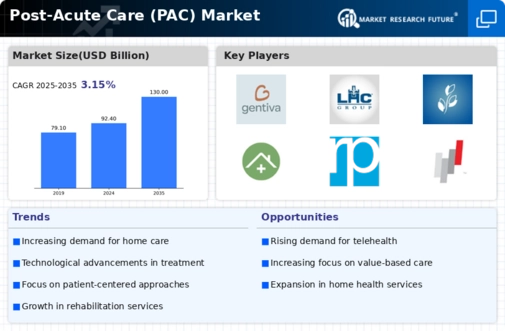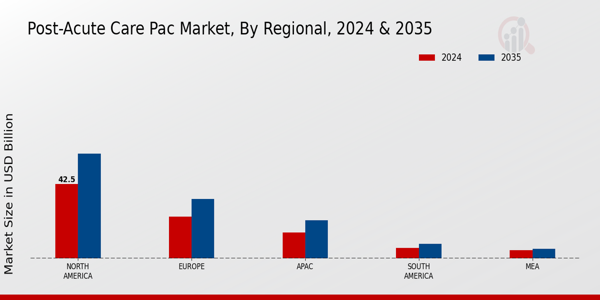Aging Population
The Global Post-Acute Care (PAC) Market Industry is experiencing a notable surge driven by the aging population. As individuals age, they often require specialized care following hospital stays, which increases demand for post-acute services. By 2024, the market is projected to reach 92.4 USD Billion, reflecting the growing need for rehabilitation and long-term care facilities. This demographic shift is expected to continue, with a significant portion of the population over 65 years old by 2035. The implications for PAC services are profound, as healthcare systems adapt to meet the needs of this expanding demographic.
Market Growth Charts
Chronic Disease Prevalence
The rise in chronic diseases is a pivotal factor influencing the Global Post-Acute Care (PAC) Market Industry. Chronic conditions such as diabetes, heart disease, and respiratory disorders necessitate ongoing care and rehabilitation, often extending beyond initial hospital treatment. This trend is likely to drive the market's growth, with projections indicating a market value of 130 USD Billion by 2035. As healthcare providers increasingly focus on managing chronic illnesses, the demand for PAC services is expected to rise, highlighting the need for integrated care models that address both acute and post-acute needs.
Technological Advancements
Technological innovations are reshaping the Global Post-Acute Care (PAC) Market Industry, enhancing the quality and efficiency of care delivery. Telehealth services, electronic health records, and remote monitoring technologies are becoming integral to PAC, enabling providers to offer more personalized and timely care. These advancements not only improve patient outcomes but also streamline operational processes, potentially reducing costs. As the industry evolves, the integration of technology is expected to play a crucial role in meeting the projected market growth, with a compound annual growth rate of 3.16% anticipated from 2025 to 2035.
Patient-Centric Care Models
The shift towards patient-centric care models is a driving force in the Global Post-Acute Care (PAC) Market Industry. Healthcare systems are increasingly focusing on individualized care plans that prioritize patient preferences and needs. This approach not only enhances patient satisfaction but also improves health outcomes, thereby reducing the overall cost of care. As more providers adopt these models, the demand for PAC services is expected to rise, contributing to the market's projected growth. The emphasis on personalized care is likely to reshape service delivery in the coming years.
Policy and Regulatory Changes
The Global Post-Acute Care (PAC) Market Industry is significantly influenced by evolving healthcare policies and regulations. Governments worldwide are increasingly recognizing the importance of post-acute care in improving patient outcomes and reducing hospital readmissions. Legislative changes aimed at enhancing care coordination and reimbursement models are likely to drive investment in PAC services. As policies continue to evolve, they may create new opportunities for providers, ensuring that they can meet the growing demand for post-acute services in a more structured and financially viable manner.














